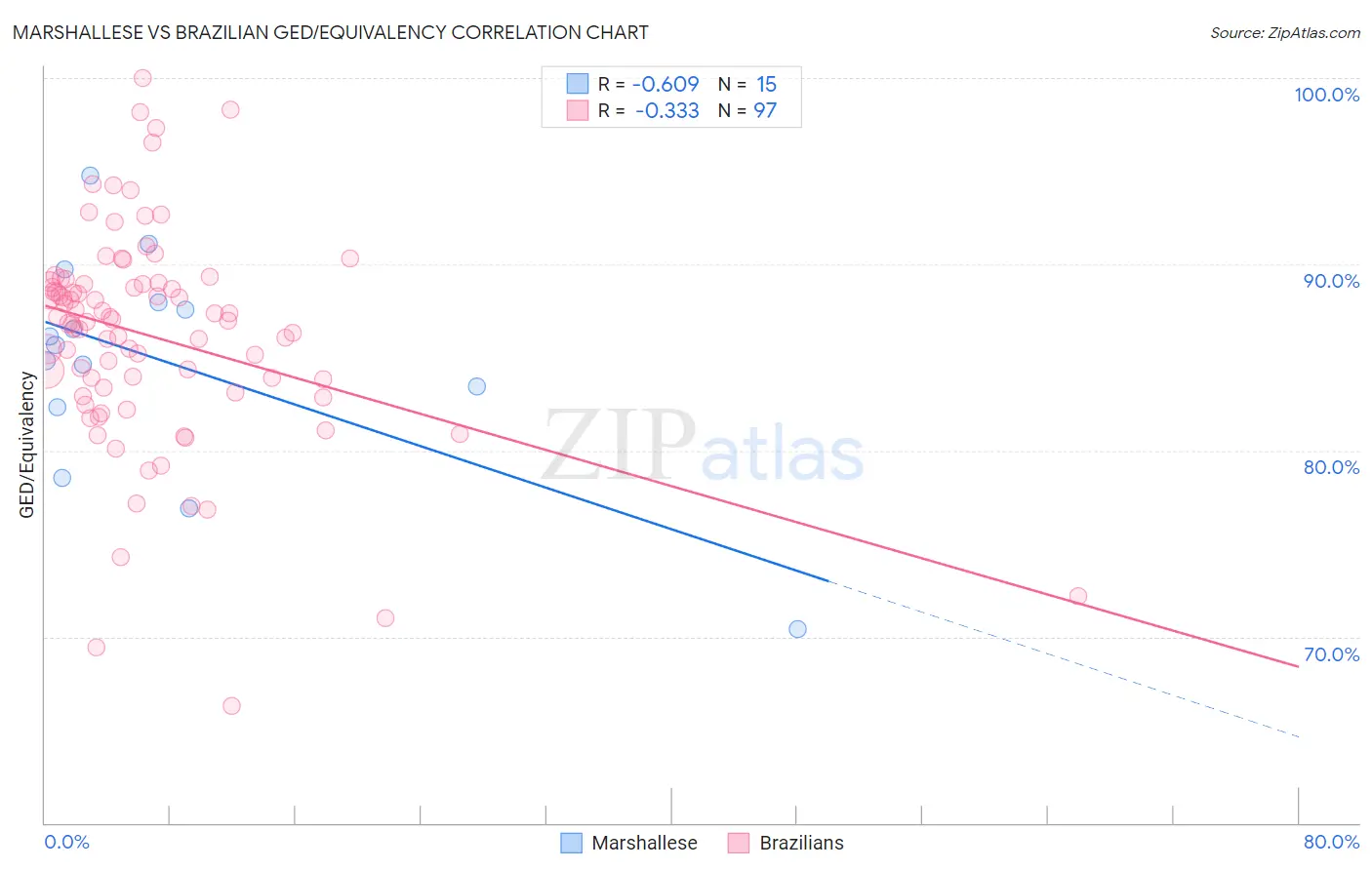Marshallese vs Brazilian GED/Equivalency
COMPARE
Marshallese
Brazilian
GED/Equivalency
GED/Equivalency Comparison
Marshallese
Brazilians
84.9%
GED/EQUIVALENCY
12.5/ 100
METRIC RATING
208th/ 347
METRIC RANK
86.3%
GED/EQUIVALENCY
77.2/ 100
METRIC RATING
152nd/ 347
METRIC RANK
Marshallese vs Brazilian GED/Equivalency Correlation Chart
The statistical analysis conducted on geographies consisting of 14,760,991 people shows a significant negative correlation between the proportion of Marshallese and percentage of population with at least ged/equivalency education in the United States with a correlation coefficient (R) of -0.609 and weighted average of 84.9%. Similarly, the statistical analysis conducted on geographies consisting of 323,949,291 people shows a mild negative correlation between the proportion of Brazilians and percentage of population with at least ged/equivalency education in the United States with a correlation coefficient (R) of -0.333 and weighted average of 86.3%, a difference of 1.6%.

GED/Equivalency Correlation Summary
| Measurement | Marshallese | Brazilian |
| Minimum | 70.4% | 66.3% |
| Maximum | 94.8% | 100.0% |
| Range | 24.4% | 33.7% |
| Mean | 84.7% | 86.1% |
| Median | 85.7% | 87.0% |
| Interquartile 25% (IQ1) | 82.3% | 83.3% |
| Interquartile 75% (IQ3) | 88.0% | 89.0% |
| Interquartile Range (IQR) | 5.6% | 5.7% |
| Standard Deviation (Sample) | 6.0% | 5.8% |
| Standard Deviation (Population) | 5.8% | 5.8% |
Similar Demographics by GED/Equivalency
Demographics Similar to Marshallese by GED/Equivalency
In terms of ged/equivalency, the demographic groups most similar to Marshallese are Colombian (84.9%, a difference of 0.010%), Immigrants from Cameroon (84.9%, a difference of 0.020%), Hmong (84.9%, a difference of 0.030%), Samoan (84.9%, a difference of 0.050%), and South American (84.8%, a difference of 0.080%).
| Demographics | Rating | Rank | GED/Equivalency |
| Portuguese | 15.9 /100 | #201 | Poor 85.0% |
| Cree | 15.9 /100 | #202 | Poor 85.0% |
| Panamanians | 15.3 /100 | #203 | Poor 85.0% |
| Hawaiians | 15.2 /100 | #204 | Poor 85.0% |
| Liberians | 14.6 /100 | #205 | Poor 85.0% |
| Samoans | 13.7 /100 | #206 | Poor 84.9% |
| Hmong | 13.1 /100 | #207 | Poor 84.9% |
| Marshallese | 12.5 /100 | #208 | Poor 84.9% |
| Colombians | 12.3 /100 | #209 | Poor 84.9% |
| Immigrants | Cameroon | 12.1 /100 | #210 | Poor 84.9% |
| South Americans | 10.9 /100 | #211 | Poor 84.8% |
| Immigrants | Somalia | 10.6 /100 | #212 | Poor 84.8% |
| Immigrants | Philippines | 10.0 /100 | #213 | Poor 84.8% |
| Osage | 9.5 /100 | #214 | Tragic 84.8% |
| Peruvians | 9.2 /100 | #215 | Tragic 84.7% |
Demographics Similar to Brazilians by GED/Equivalency
In terms of ged/equivalency, the demographic groups most similar to Brazilians are Immigrants from Bosnia and Herzegovina (86.3%, a difference of 0.020%), Kenyan (86.3%, a difference of 0.020%), Armenian (86.3%, a difference of 0.020%), Immigrants from Western Asia (86.3%, a difference of 0.050%), and Immigrants from Poland (86.3%, a difference of 0.060%).
| Demographics | Rating | Rank | GED/Equivalency |
| Pakistanis | 80.4 /100 | #145 | Excellent 86.4% |
| Basques | 79.5 /100 | #146 | Good 86.4% |
| Immigrants | Northern Africa | 79.3 /100 | #147 | Good 86.3% |
| Immigrants | Poland | 79.3 /100 | #148 | Good 86.3% |
| Menominee | 79.3 /100 | #149 | Good 86.3% |
| Immigrants | Western Asia | 78.8 /100 | #150 | Good 86.3% |
| Immigrants | Bosnia and Herzegovina | 77.9 /100 | #151 | Good 86.3% |
| Brazilians | 77.2 /100 | #152 | Good 86.3% |
| Kenyans | 76.6 /100 | #153 | Good 86.3% |
| Armenians | 76.4 /100 | #154 | Good 86.3% |
| Iraqis | 75.2 /100 | #155 | Good 86.2% |
| Immigrants | Nepal | 73.3 /100 | #156 | Good 86.2% |
| Whites/Caucasians | 72.2 /100 | #157 | Good 86.2% |
| German Russians | 72.1 /100 | #158 | Good 86.2% |
| Immigrants | Kenya | 71.8 /100 | #159 | Good 86.2% |